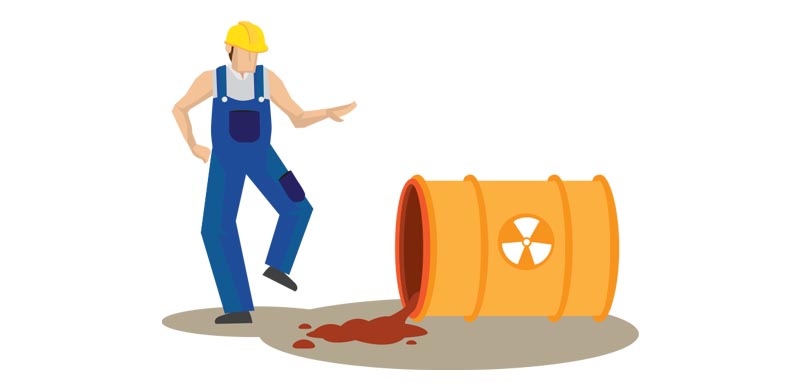Key Points: Learn how to Assess a liquid spill in the workplace and Identify risks to staff and/or equipment.
When a liquid spill occurs in the workplace there’s a natural tendency to quickly get to the location of the spill and begin the clean up process as quickly as possible.
But there’s a number of points to consider in the event of a spill that must take place first, including:
-
- Identifying the location and source of the spill
- Identifying the type of material spilled and potential hazards to staff including if there is a risk of fire due to flammable liquid spills and ignition sources in the vicinity
- Assessing whether equipment may be damaged as a result of the spill
- Assessing whether the spill can be contained before entering drains
- Ensuring those responsible for clean up have the appropriate PPE (personal protective equipment) on hand
- Using the correct product and procedures to effectively manage the spill
- Reporting the spill if required to local authorities
Following a standard operating procedure or environmental management plan (that takes into account the points listed above will help you minimise the impact of a liquid spill, improve your response times (reducing the impact of the spill), and minimise potential threats to staff and/or equipment.
The most effective way to minimise the impacts of a liquid spill in the workplace is to ensure you and/or your staff (depending on the size of your operation) have undertaken spill response training, are assigned roles and understand what they are required to do in the event of a liquid spill and can easily locate PPE and spill clean up equipment quickly and understand their responsibilities when it comes to reporting a liquid spill event.
Ensuring your liquid products are suitably stored in bunded areas is also key but that won’t rule out the fact that from time to time you may need to use/move and handle stored liquids and with that contact, the greater the opportunity to create a spill risk. Therefore ensuring you have a bunded area for storage should also form a central part of your mitigation strategy.

Spill Identification
When a spill occurs in the workplace the first thing you should do, after locating the source is to assess all potential risks to staff, equipment and the environment.
Identifying Risks For Staff
Liquid spills can present an immediate and indirect health risk to staff and responders. For instance, if a staff member is located within the spill area and injured or even unconscious, you should never rush straight in to assist and risk a similar fate without first knowing:
- Is the liquid hazardous to health if inhaled?
- Is the liquid flammable e.g. a fuel source that could start a fire?
- Is there a potential source of ignition in the area that could increase the risk of fire if the liquid spill is flammable?
- Is the liquid corrosive to nearby materials or equipment?
- Is the spill resulting in foaming or presenting an unusual odour?
- Is there a risk of electrocution?
- Is there a clear and present danger to staff within the immediate area of the spill or adjacent areas?
- Could the liquid react with other liquids present in the immediate area of the spill and if so what impact may this have?
- Can the weather have an impact on how the spill is mitigated?
Once you have assessed the situation taking into account the five points listed above you will be able to make an informed decision about the immediate response required and be able to answer the following questions:
- Should staff be evacuated?
- Should an alarm be triggered or a supervisor informed?
- Should all power to the area be switched off?
- Should the area be barricaded?
- Should you display signage indicating a trip hazard?
Identifying Risks To Equipment
If equipment is located within or near the spill area you should ask:
- Does the equipment utilise a flammable fuel source?
- Is there a risk of electrical components coming into contact with the liquid presenting a risk for electrocution?
- Can the equipment be relocated?
- Are there measures I can take to protect the equipment if unable to be moved? E.g. can it be covered or contained?
If any of the points listed above are a potential concern and you have already taken measures to protect staff in the event of a hazardous spill you should next either remove or take precautions to prevent damage to your equipment.
Identifying Risks To The Environment
Lastly, but also importantly you must assess potential risks to the environment e.g. business owners face heavy fines if they are unprepared in the event of a spill and hazardous contaminants enter the stormwater network.
You should ask yourself:
Do you need to block drains to prevent the liquid entering the stormwater network.
Can you bund the immediate area to prevent the spill spreading.
What If The Liquid Cannot Be Identified?
If there is no immediate way to identify the liquid and any hazards it may present to staff, equipment or the environment it’s best to assume it is hazardous e.g. noxious, flammable, may damage equipment and may impact the environment and take the necessary steps to mitigate the risk. If later on you assess that the liquid is not hazardous, you have taken the correct precautions and no harm is done.
Summary
Only by following correct procedure, locating the source of the spill, identifying potential risks to staff, equipment and the environment can you make an informed decision on the most effective response to a liquid spill at your workplace and mitigate risks and/or disruptions.


